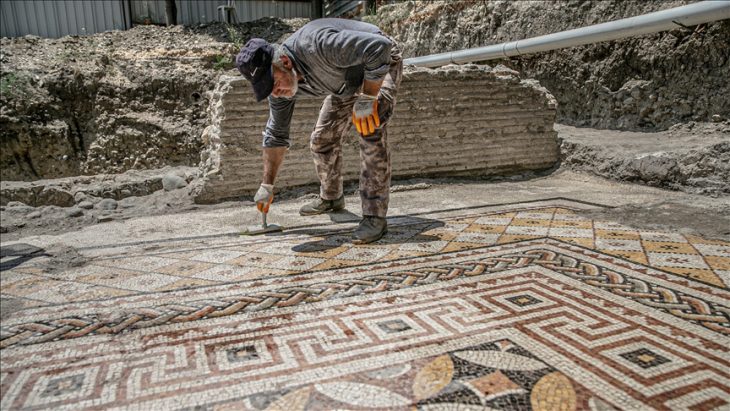During the foundation excavation of a construction in the Defne district of Hatay, wall remains of a Roman villa and a geometrically patterned floor mosaic were found.
A historical building was encountered during the foundation excavation of the construction to be built on the site of an 8-storey building that was destroyed in the scope of urban transformation in December 2021 in the Sümerler District.
Upon reporting the situation to the Hatay Archeology Museum Directorate, the work in the area was stopped and an investigation was started.
In the examination carried out by the archaeologists in the area, it was determined that the ruins were the wall of a Roman villa and that there was a floor mosaic with geometric decoration on its floor.
Rescue excavations were started about a month ago in the construction site, which was taken under protection.
Ayşe Ersoy, Director of Hatay Archeology Museum, told Anadolu Agency that traces of many artifacts from that period were found in the city, which was called Antiochia during the Roman Empire.
Ersoy, who stated that the rescue excavation continues with the sponsorship of Defne Municipality, in the area where the remains were found during the foundation excavation, with an archaeologist, art historian and 11 workers, and gave the following information:
“Floor mosaics and wall remains of a Roman villa were unearthed. Based on the ruins and small finds, we determined that this place was inhabited until the 2nd and 5th centuries. Antiochia was settled in a large area between the Orontes River and the Habib-i Neccar Mountains. “It was the third largest city in the Roman Imperial period after Rome and Constantinople. Its area of spread is very wide. The road of Antiochia, which starts from the Aleppo gate, goes up to the Defne gate, and there are settlements along the way. This is a villa and its ruins from that period.”
Ersoy said that during the excavations, they found that some of the villa wall remains and some of the floor mosaic were damaged.
Noting that there was no possibility to expand the salvage excavation due to the presence of multi-storey buildings around, Ersoy said:
“In the coming days, we will drill a sounding in the adjacent parcel to determine whether the area where the historical remains are found continues and we will present the matter to the conservation committee. Then it will be decided whether the artifacts will be moved.”
